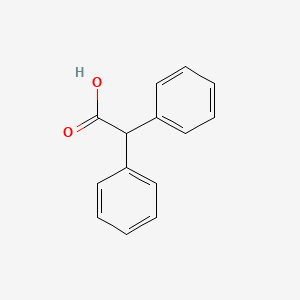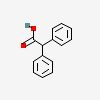Diphenylacetic acid
- DIPHENYLACETIC ACID
- 2,2-diphenylacetic acid
- 117-34-0
- Diphenylethanoic acid
- Acetic acid, diphenyl-
- Create:2005-03-26
- Modify:2025-01-18

- diphenylacetic acid
- diphenylacetic acid, potassium salt
- diphenylacetic acid, sodium salt
- DIPHENYLACETIC ACID
- 2,2-diphenylacetic acid
- 117-34-0
- Diphenylethanoic acid
- Acetic acid, diphenyl-
- Benzeneacetic acid, .alpha.-phenyl-
- Benzeneacetic acid, alpha-phenyl-
- MFCD00004251
- alpha-phenylbenzeneacetic acid
- diphenyl acetic acid
- Diphenyl-acetic acid
- .alpha.,.alpha.-Diphenylacetic acid
- 658NCZ0NKO
- CHEBI:41967
- NSC-8742
- NSC-120417
- .alpha.-Toluic acid, .alpha.-phenyl-
- 1,1-Diphenylacetic acid
- alpha-Toluic acid, alpha-phenyl-
- 2,2-Diphenylaceticacid
- EINECS 204-185-0
- UNII-658NCZ0NKO
- NSC 120417
- 2,2-di(phenyl)acetic acid
- BRN 1910978
- AI3-23777
- Diphenylmethane-alpha-carboxylic Acid
- 2,2-diphenyl-acetic acid
- bmse000721
- Diphenylacetic acid, 99%
- Oprea1_633306
- SCHEMBL38022
- 4-09-00-02492 (Beilstein Handbook Reference)
- MLS001066368
- CHEMBL1232181
- DIPHENYLACETIC ACID [MI]
- DTXSID0059453
- PYHXGXCGESYPCW-UHFFFAOYSA-
- NSC8742
- HMS2270K07
- Benzeneacetic acid, I+/--phenyl-
- HY-Y0549
- STR02769
- AR3860
- BBL013452
- NSC120417
- STK297834
- AKOS000119583
- CS-W008595
- DB03588
- PB39724
- .ALPHA.-PHENYLBENZENEACETIC ACID
- NCGC00247023-01
- SMR000112185
- SY011402
- DB-060999
- D0869
- NS00023782
- EN300-20209
- D-6050
- SR-01000389184
- SR-01000389184-1
- Diphenylacetic acid-Melting point 147.26 degrees C
- Q27094513
- Diphenylacetic acid - Melting point 147.26 masculineC
- F0347-1724
- Z104477292
- InChI=1/C14H12O2/c15-14(16)13(11-7-3-1-4-8-11)12-9-5-2-6-10-12/h1-10,13H,(H,15,16)
167.0 99.99
212.0 29.07
165.0 27.95
168.0 18.27
152.0 13.38
167 99.99
212 29.07
165 27.95
168 18.27
152 13.38
127.086136 15644
141.101166 14720
245.116669 13880
203.06929 9128
217.120102 8408
152.062195 100
167.083557 98.71
165.070114 65.27
107.051018 38.26
135.045837 22.51
167 999
212 291
165 280
168 183
152 134



H302 (50%): Harmful if swallowed [Warning Acute toxicity, oral]
H311 (33.3%): Toxic in contact with skin [Danger Acute toxicity, dermal]
H315 (91.7%): Causes skin irritation [Warning Skin corrosion/irritation]
H319 (62.5%): Causes serious eye irritation [Warning Serious eye damage/eye irritation]
H331 (33.3%): Toxic if inhaled [Danger Acute toxicity, inhalation]
H332 (33.3%): Harmful if inhaled [Warning Acute toxicity, inhalation]
H335 (25%): May cause respiratory irritation [Warning Specific target organ toxicity, single exposure; Respiratory tract irritation]
H400 (33.3%): Very toxic to aquatic life [Warning Hazardous to the aquatic environment, acute hazard]
P261, P262, P264, P264+P265, P270, P271, P273, P280, P301+P317, P302+P352, P304+P340, P305+P351+P338, P316, P317, P319, P321, P330, P332+P317, P337+P317, P361+P364, P362+P364, P391, P403+P233, P405, and P501
(The corresponding statement to each P-code can be found at the GHS Classification page.)
Aggregated GHS information provided per 24 reports by companies from 10 notifications to the ECHA C&L Inventory. Each notification may be associated with multiple companies.
Reported as not meeting GHS hazard criteria per 1 of 24 reports by companies. For more detailed information, please visit ECHA C&L website.
There are 9 notifications provided by 23 of 24 reports by companies with hazard statement code(s).
Information may vary between notifications depending on impurities, additives, and other factors. The percentage value in parenthesis indicates the notified classification ratio from companies that provide hazard codes. Only hazard codes with percentage values above 10% are shown.
Acute Tox. 4 (50%)
Skin Irrit. 2 (91.7%)
Eye Irrit. 2 (62.5%)
STOT SE 3 (25%)
Status: Cease Manufacture Update: 07-04-2017 https://echa.europa.eu/registration-dossier/-/registered-dossier/19242
Status: Active Update: 09-05-2018 https://echa.europa.eu/registration-dossier/-/registered-dossier/25899
Patents are available for this chemical structure:
https://patentscope.wipo.int/search/en/result.jsf?inchikey=PYHXGXCGESYPCW-UHFFFAOYSA-N
- Australian Industrial Chemicals Introduction Scheme (AICIS)Benzeneacetic acid, .alpha.-phenyl-https://services.industrialchemicals.gov.au/search-inventory/
- CAS Common ChemistryLICENSEThe data from CAS Common Chemistry is provided under a CC-BY-NC 4.0 license, unless otherwise stated.https://creativecommons.org/licenses/by-nc/4.0/Diphenylacetic acidhttps://commonchemistry.cas.org/detail?cas_rn=117-34-0
- ChemIDplusDiphenylacetic acidhttps://pubchem.ncbi.nlm.nih.gov/substance/?source=chemidplus&sourceid=0000117340ChemIDplus Chemical Information Classificationhttps://pubchem.ncbi.nlm.nih.gov/source/ChemIDplus
- DrugBankLICENSECreative Common's Attribution-NonCommercial 4.0 International License (http://creativecommons.org/licenses/by-nc/4.0/legalcode)https://www.drugbank.ca/legal/terms_of_useDiphenylacetic acidhttps://www.drugbank.ca/drugs/DB03588
- DTP/NCILICENSEUnless otherwise indicated, all text within NCI products is free of copyright and may be reused without our permission. Credit the National Cancer Institute as the source.https://www.cancer.gov/policies/copyright-reuse
- EPA Chemicals under the TSCABenzeneacetic acid, .alpha.-phenyl-https://www.epa.gov/chemicals-under-tscaEPA TSCA Classificationhttps://www.epa.gov/tsca-inventory
- EPA DSSToxBenzeneacetic acid, .alpha.-phenyl-https://comptox.epa.gov/dashboard/DTXSID0059453CompTox Chemicals Dashboard Chemical Listshttps://comptox.epa.gov/dashboard/chemical-lists/
- European Chemicals Agency (ECHA)LICENSEUse of the information, documents and data from the ECHA website is subject to the terms and conditions of this Legal Notice, and subject to other binding limitations provided for under applicable law, the information, documents and data made available on the ECHA website may be reproduced, distributed and/or used, totally or in part, for non-commercial purposes provided that ECHA is acknowledged as the source: "Source: European Chemicals Agency, http://echa.europa.eu/". Such acknowledgement must be included in each copy of the material. ECHA permits and encourages organisations and individuals to create links to the ECHA website under the following cumulative conditions: Links can only be made to webpages that provide a link to the Legal Notice page.https://echa.europa.eu/web/guest/legal-noticeDiphenylacetic acidhttps://chem.echa.europa.eu/100.003.805Diphenylacetic acid (EC: 204-185-0)https://echa.europa.eu/information-on-chemicals/cl-inventory-database/-/discli/details/11252
- FDA Global Substance Registration System (GSRS)LICENSEUnless otherwise noted, the contents of the FDA website (www.fda.gov), both text and graphics, are not copyrighted. They are in the public domain and may be republished, reprinted and otherwise used freely by anyone without the need to obtain permission from FDA. Credit to the U.S. Food and Drug Administration as the source is appreciated but not required.https://www.fda.gov/about-fda/about-website/website-policies#linkingDIPHENYLACETIC ACIDhttps://gsrs.ncats.nih.gov/ginas/app/beta/substances/658NCZ0NKO
- New Zealand Environmental Protection Authority (EPA)LICENSEThis work is licensed under the Creative Commons Attribution-ShareAlike 4.0 International licence.https://www.epa.govt.nz/about-this-site/general-copyright-statement/
- ChEBIDiphenylacetic acidhttps://www.ebi.ac.uk/chebi/searchId.do?chebiId=CHEBI:41967
- LOTUS - the natural products occurrence databaseLICENSEThe code for LOTUS is released under the GNU General Public License v3.0.https://lotus.nprod.net/Diphenylacetic acidhttps://www.wikidata.org/wiki/Q22977245LOTUS Treehttps://lotus.naturalproducts.net/
- ChEMBLLICENSEAccess to the web interface of ChEMBL is made under the EBI's Terms of Use (http://www.ebi.ac.uk/Information/termsofuse.html). The ChEMBL data is made available on a Creative Commons Attribution-Share Alike 3.0 Unported License (http://creativecommons.org/licenses/by-sa/3.0/).http://www.ebi.ac.uk/Information/termsofuse.html
- Comparative Toxicogenomics Database (CTD)LICENSEIt is to be used only for research and educational purposes. Any reproduction or use for commercial purpose is prohibited without the prior express written permission of NC State University.http://ctdbase.org/about/legal.jspdiphenylacetic acidhttps://ctdbase.org/detail.go?type=chem&acc=C037760
- Therapeutic Target Database (TTD)Diphenylacetic Acidhttps://idrblab.net/ttd/data/drug/details/D0X0IT
- Crystallography Open Database (COD)LICENSEAll data in the COD and the database itself are dedicated to the public domain and licensed under the CC0 License. Users of the data should acknowledge the original authors of the structural data.https://creativecommons.org/publicdomain/zero/1.0/
- Haz-Map, Information on Hazardous Chemicals and Occupational DiseasesLICENSECopyright (c) 2022 Haz-Map(R). All rights reserved. Unless otherwise indicated, all materials from Haz-Map are copyrighted by Haz-Map(R). No part of these materials, either text or image may be used for any purpose other than for personal use. Therefore, reproduction, modification, storage in a retrieval system or retransmission, in any form or by any means, electronic, mechanical or otherwise, for reasons other than personal use, is strictly prohibited without prior written permission.https://haz-map.com/AboutDiphenylacetic acidhttps://haz-map.com/Agents/20639
- Human Metabolome Database (HMDB)LICENSEHMDB is offered to the public as a freely available resource. Use and re-distribution of the data, in whole or in part, for commercial purposes requires explicit permission of the authors and explicit acknowledgment of the source material (HMDB) and the original publication (see the HMDB citing page). We ask that users who download significant portions of the database cite the HMDB paper in any resulting publications.http://www.hmdb.ca/citingDiphenylacetic acidhttp://www.hmdb.ca/metabolites/HMDB0251455HMDB0251455_cms_29893https://hmdb.ca/metabolites/HMDB0251455#spectra
- MassBank of North America (MoNA)LICENSEThe content of the MoNA database is licensed under CC BY 4.0.https://mona.fiehnlab.ucdavis.edu/documentation/license
- NIST Mass Spectrometry Data CenterLICENSEData covered by the Standard Reference Data Act of 1968 as amended.https://www.nist.gov/srd/public-lawBenzeneacetic acid, .alpha.-phenyl-http://www.nist.gov/srd/nist1a.cfm
- SpectraBasePIPERIDOLATE-ARTIFACThttps://spectrabase.com/spectrum/KYdTBmDxiPIBENACTYZINE-ARTIFACT 1https://spectrabase.com/spectrum/GrrRIO5gV7YDiphenylacetic acidhttps://spectrabase.com/spectrum/AuElhvTkH8LDiphenylacetic acidhttps://spectrabase.com/spectrum/A1yYx1y0FRzDiphenylacetic acidhttps://spectrabase.com/spectrum/35OgQpGHjeSDiphenyl acetic acidhttps://spectrabase.com/spectrum/3HXWPAOh7QaDiphenylacetic acidhttps://spectrabase.com/spectrum/3QS0jW2UPk5Diphenylacetic acidhttps://spectrabase.com/spectrum/CWbT94IaSikDiphenylacetic acidhttps://spectrabase.com/spectrum/Il0D7x04vk1Diphenylacetic acidhttps://spectrabase.com/spectrum/HEiIuls8lLgDiphenylacetic acidhttps://spectrabase.com/spectrum/7VsKoQdTZRDiphenylacetic acidhttps://spectrabase.com/spectrum/yO8R1pB0Oo
- Japan Chemical Substance Dictionary (Nikkaji)
- MassBank EuropeDIPHENYLACETIC ACIDhttps://massbank.eu/MassBank/Result.jsp?inchikey=PYHXGXCGESYPCW-UHFFFAOYSA-N
- Metabolomics WorkbenchDIPHENYLACETIC ACIDhttps://www.metabolomicsworkbench.org/data/StructureData.php?RegNo=67558
- NMRShiftDB
- NORMAN Suspect List ExchangeLICENSEData: CC-BY 4.0; Code (hosted by ECI, LCSB): Artistic-2.0https://creativecommons.org/licenses/by/4.0/Diphenylacetic AcidNORMAN Suspect List Exchange Classificationhttps://www.norman-network.com/nds/SLE/
- Protein Data Bank in Europe (PDBe)
- RCSB Protein Data Bank (RCSB PDB)LICENSEData files contained in the PDB archive (ftp://ftp.wwpdb.org) are free of all copyright restrictions and made fully and freely available for both non-commercial and commercial use. Users of the data should attribute the original authors of that structural data.https://www.rcsb.org/pages/policies
- Springer Nature
- SpringerMaterialsBenzeneacetic acid, α-phenyl-https://materials.springer.com/substanceprofile/docs/smsid_nykzwgvkqxkeiqrg
- The Cambridge Structural Database
- Thieme ChemistryLICENSEThe Thieme Chemistry contribution within PubChem is provided under a CC-BY-NC-ND 4.0 license, unless otherwise stated.https://creativecommons.org/licenses/by-nc-nd/4.0/
- Wikidatadiphenylacetic acidhttps://www.wikidata.org/wiki/Q22977245
- Wiley
- PubChem
- Medical Subject Headings (MeSH)LICENSEWorks produced by the U.S. government are not subject to copyright protection in the United States. Any such works found on National Library of Medicine (NLM) Web sites may be freely used or reproduced without permission in the U.S.https://www.nlm.nih.gov/copyright.htmldiphenylacetic acidhttps://www.ncbi.nlm.nih.gov/mesh/67037760
- GHS Classification (UNECE)GHS Classification Treehttp://www.unece.org/trans/danger/publi/ghs/ghs_welcome_e.html
- EPA Substance Registry ServicesEPA SRS List Classificationhttps://sor.epa.gov/sor_internet/registry/substreg/LandingPage.do
- MolGenieMolGenie Organic Chemistry Ontologyhttps://github.com/MolGenie/ontology/
- PATENTSCOPE (WIPO)SID 403030396https://pubchem.ncbi.nlm.nih.gov/substance/403030396






